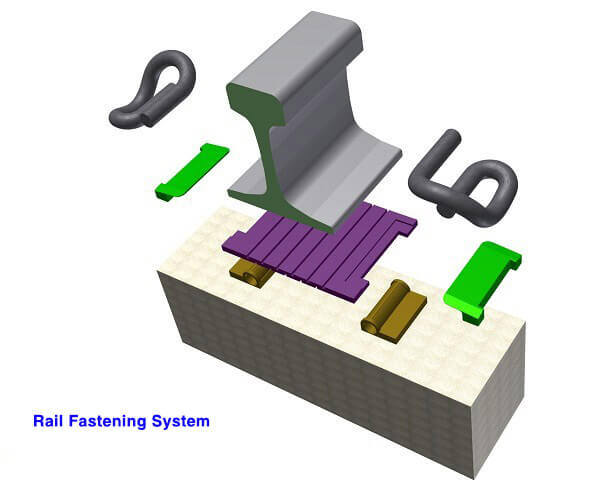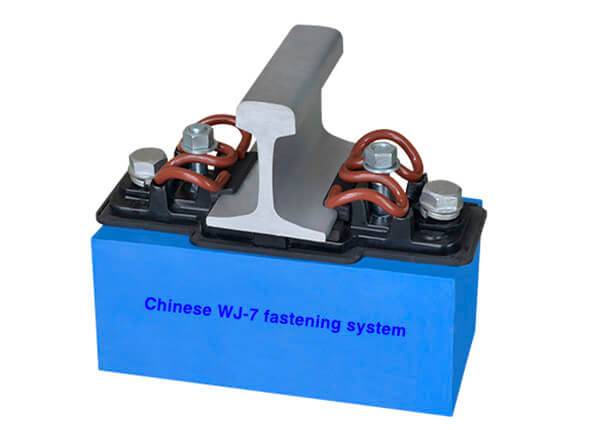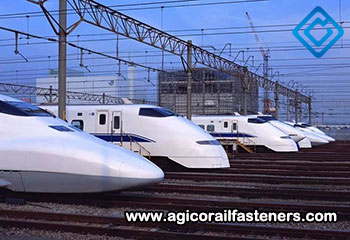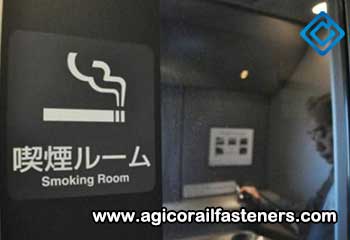Type and Application of Rail Fastening System for High-Speed Railway
The rail fastening system is the main part forming a connecting with both rail and sleeper to ensure the reliability and stability of rail track. The elasticity of non-ballasted track basically depends on rail fastening system, the accuracy of non-ballasted also depends on the fastening system to adjust and maintain. As you can see, the importance for high-speed railway and the direct impact for transportation of the fastening system are obvious, which has been the key technology related to the success or failure of non ballasted track.
1. Type of Rail Fastening System for High-Speed Railway
Rail fastening system for high-speed railway consists of clip (or blade), fasteners and base plate. The high-speed railway adopts the elastic fastening system. With the development of high-speed railway, Japan, Germany, France, Britain, Japan, China and other countries has developed out their own rail fastening systems respectively based on learning from each other.
Rail fastening systems for high-speed railway can be classified by different methods.
(1) Rail Fastening Systems Divid According to Clamping Forms
According to different clamping forms, there are two types of clip and blade. Clip type includes German SKL fastening systems and Chinese IV, V, WJ-7 and WJ-8 fastening systems. Blade type includes Japanese Direct fastening systems.
(2) Rail Fastening Systems Divid According to Bearing Modes
According to different bearing modes of horizontal force, it shall be divided into two types of rail fastening system with shoulder and rail fastening system without shoulder. The former type is needed to pre-set supporting rail ditch on the sleeper or track slab to bear horizontal force rail generates when train is passing. The latter type is not needed to pre-set, rail anchor bolt and friction force shall bear all horizontal force.
The former representative systems include German SKL 300 fastening system, Japanese Direct4 fastening system and Chinese V, WJ-8 fastening systems. The latter representative systems include Japanese Direct 8 fastening system, German Krupp ECF fastening system and Chinese IV, WJ-7 fastening systems.
(3) Rail Fastening Systems Divid According to Fastening Forms
According to different fastening forms, it can be divided into two types, that is, rail fastening system with bolt and rail fastening system without bolt. Except Chinese IV fastening system, all the rest fastening systems adopt bolt fastening form.
(4) Rail Fastening Systems Divid According to Connection Ways With Track Bed
According to different ways of the connection with track bed, it can be divided into separated and unseparated types. Separated type must consist of tie plate on which clip (or blade) is firmly fixed, which is connected by anchor bolts and plastic insulated dowels pre-embedded in sleeper or track slab. Unseparated type doesn’t usually consist of tie plate (except German SKL 300 fastening system and Chinese WJ-8 fastening system); there is only a layer of rail pad under rail between rail and sleeper or track slab. The fasteners of rail fastening system such as rail screw, rail bolt and nut straightly connect with dowels of concrete sleeper or concrete slab. Representative systems of separated type include Japanese Direct8 fastening system,
German Krupp ECF fastening system and Chinese WJ-7 fastening system. And representative systems of unseparated type include German SKL 300 fastening system, Japanese Direct4 fastening system and Chinese V, WJ-8 fastening systems.
(5) Rail Fastening Systems Divid According to Adjusting Modes of Gauge
According to different adjusting modes of gauge, it can be divided into step adjustment and stepless adjustment. Japanese Direct8, Direct8K fastening systems and Chinese WJ-7 fastening system belong to stepless adjustment, the other fastening systems step adjustment.
2. Rail Fastening System for High-Speed Railway and Component Performance
The elastic characteristics of rail fastening system play the crucial role in noise reduction and impact on steel rail for non-ballasted track.
(1) Clip (or Blade)
Clip (or Blade) for high-speed railway has the characteristics of elastic deformation following the rail deformation, uneasily loosing and fatigue resistance. In terms of its elastic properties, blade has the advantages of relatively simple shape, easy production process and low cost, mainly using bending deformation performance of its manufactured material. But due to meet the requirements of fastening bolts, here exists the problem of hole opening, and then stress concentration around the hole is prone to cause damage of blade. Furthermore, the place of maximum bending moment is exactly the weakest part of the section, which easily cause to damage. Therefore, clamping force and elasticity of blade are insufficient. While Clip is made use of bending deformation performance as well as torsion deformation performance, so clip elasticity is better and utilization of the material higher. Performance requirements are as follows:
A. Rigidity of the front end of clip shall be smaller;
B. Stress changes shall be limited in the fatigue of spring steel;
C. Adjustability of clip shall be better and clamping force is under control;
D. Natural frequency of clip must not be equivalent to the counterpart of tie plate, in order to avoid of its loosening caused by vibration.
In German SKL 300 fastening system, the raw material of the clip is φ15mm spring steel made of 38Si7 through the processes of quenching and tempering hot-rolling.
Table 1 Main Chemical Composition of 38Si7 (mass fraction) (%)
| C | Si | Mn | P | S |
|---|---|---|---|---|
| 0.35-0.42 | 1.5-1.8 | 0.5-0.8 | ≤0.025 | ≤0.025 |
Chinese IV clip, V clip, WJ-7 clip and WJ-8 clip are made of 60Si2MnA spring steel of which main chemical composition is seen as Table 2. IV clip is made ofφ20mm hot-rolled spring steel, which heat treatment hardness is 44-48HRC and surface decarburization layer does not exceed 0.25mm. V clip, WJ-7 clip and WJ-8 clip are all made ofφ14mm hot-rolled spring steel. X2 clip and X3 clip is produced byφ13mm hot-rolled spring steel, which heat treatment hardness is 42-47HRC and surface decarburization layer is not more than 0.25mm.
Table 2 Main Chemical Composition of 60Si2MnA (mass fraction) (%)
| C | Si | Mn | P | S | Cr | Ni | Cu |
|---|---|---|---|---|---|---|---|
| 0.56-0.64 | 1.60-2.00 | 0.6-0.9 | ≤0.030 | ≤0.030 | ≤0.35 | ≤0.35 | ≤0.25 |
(2) Elastic base plate
Elastic base plate is a collective name, including both tie plate and elastic pad. The performance requirements are as follows:
A. To bear rail vertical force, longitudinal force and horizontal force.
B. To be enough elasticity to reduce vibration of impact on rail.
C. To be with the appropriate insulation performance.
(3) Fasteners
Mainly fasteners consist of rail anchored bolts, pre-embedded dowels and rail shoulders, which perform the functions of fixing the elastic base plates on concrete sleeper or track slab, bearing certain loading and being insulated.
3. Characteristics of Rail Fastening System for High-Speed Railway
At present, the new-built high-speed railway usually adopts non-ballasted track structure. In the world, Germany SKL 300 fastening system and Krupp ECF fastening system, Japanese Direct4 and Direct8 fastening systems are most widely used; in China, Germany SKL 300 fastening system, WJ-7 and WJ-8 fastening systems designed by China Academy of Railway Sciences are used on non-ballasted tracks.
(1) SKL 300 fastening system
SKL 300 fastening system for non-ballasted track has many advantages of simple structure, tight connection, excellent elasticity, bigger clamping force, good anti-creeping resistance, easy installation, convenient maintenance, reliable quality, long service life, etc.
SKL 300 fastening system is of a double-layer elastic structure with the pad under rail and the pad under tie plate. Its corresponding concrete sleeper must be with the supporting rail ditches. Gauge blocks that usually are insulated are used to fix and adjust gauge distance. Rail bolts and pre-embedded dowels make rail clip fix on insulated washers and gauge blocks.
SKL 300 fastening system achieves±8mm horizontal adjustment through changing different wide gauge blocks which increase or reduce 1mm every step in range of ±16mm.
SKL 300 fastening system has three ways of height adjustment, respectively by plastic adjusting pad, rail pad and steel adjusting plate. Height adjustment ranges from -4mm to 56mm. To be specific, adjustment range of rail pad is from -4mm to 2mm, increasing or reducing 1mm every step, Plastic adjusting pad together with rail pad from 3mm to 28mm; Plastic adjusting pad together with rail pad and steel adjusting plate from 29mm to 56mm.
Static rigidity of SKL 300 fastening system is 20-30kn/mm, longitudinal anti-creeping resistance≥9kn, clamping force≥18kn, clip range>15mm.
In China SKL 300 fastening system is laid on the lines of Beijing-Tianjin intercity high-speed railway, Wuhan-Guangzhou high-speed railway, Beijing-Shanghai high-speed railway, etc.
(2) Japanese Direct4K & Direct8K fastening systems
Since the 1960s, Japan began to study non-ballasted track. Japanese Direct4 & Direct8 fastening systems are put into use. At present, the main types of fastening systems are the improved Direct4K & Direct8K fastening systems.
Direct8K fastening system is a separated type structure with the tie plate. The pre-embedded plastic dowel is applied on the sleeper instead of metal dowel. On the tie plate there are oval holes opened for adjusting gauge distance through moving tie plate. Gauge adjustment range is±10mm. By rail pad, tie plate and adjusting lining pad, height adjustment range is from 0 to 70mm.
Direct4K fastening system is a structure of single elastic layer without tie plate, in which the blade straightly clamps on the rail. As the bolts are not tightened enough, only lower-leg of blade clamps on rail; as tightened enough, upper-leg also clamps on rail. The range of height adjustment is from 0mm-10mm, gauge adjustment range is ±10mm.
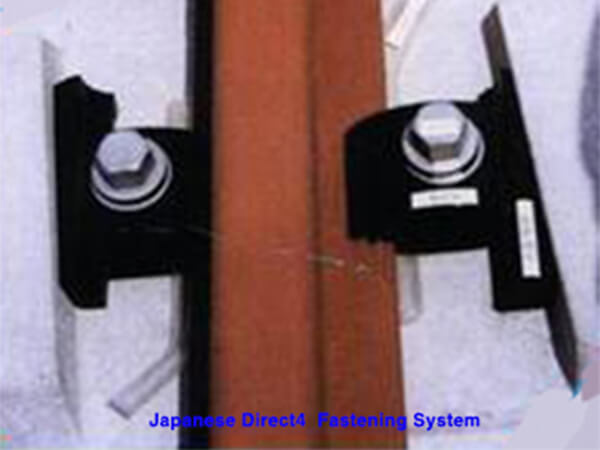
The Improved Direct4K fastening system adopts the tee hexagon bolts and spherical washer and double-deck adjustment pad. The adjustment range of the system is from 0mm-50mm, gauge adjustment range is ±10mm.
(3) Fastclip fastening system
Fastclip fastening system consists of tie plate, rail screw, flat block, insulated dowel, “W” shape clip, insulated gauge block, elastic pad and insulated baffle pad, etc.
Tie plate is fixed on the sleeper or track slab by pre-embedding dowels or anchor bolts. Fastclip fastening system is self-locking designation without the bolts. In the system “W” shape clip is applied to clamp rail and gauge adjustment is achieved by moving to left or right in the oval holes on the tie plate. The system insulation depends on insulated dowel, insulated gauge block, elastic pad and insulated baffle pad.
Insulated dowel is pre-embedded in the concrete sleeper or track slab, Fastclip fastening system shall be pre- installed on the concrete sleeper or track slab, too. On site it is just needed to screw clip tightly up to form the common entity.
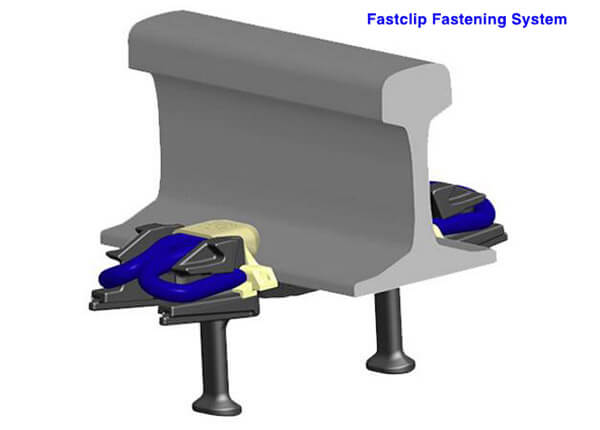
In China Fastclip fastening system is laid on the lines of Hefei-Wuhan high-speed railway, part of Wuhan-Guangzhou high-speed railway, etc.
(4) Chinese rail fastening system for high-speed railway
Recently Chinese IV, V, WJ-7 and WJ-8 fastening systems are developed out for high-speed railway. IV and V fastening systems are used to ballasted track, which can meet operation requirements of passenger line at the speed of 250 km/h. WJ-7 and WJ-8 fastening systems are used to embedded or slab non-ballasted track of bridge, tunnel and railroad base, which can meet operation requirements of line for passenger at the speed of 250 km/h (also sometimes for freight) and 350 km/h.
Chinese IV fastening system is applied to ballasted track which is laid on pre-stressed concrete sleeper without supporting rail ditches. Its gauge distance is adjustable, but height not. Longitudinal resistance of one set of the fastening system shall be >9kn. Rails of both sides can be adjusted to left or right from -4-2mm. Gauge adjustment range is from -8-4mm.
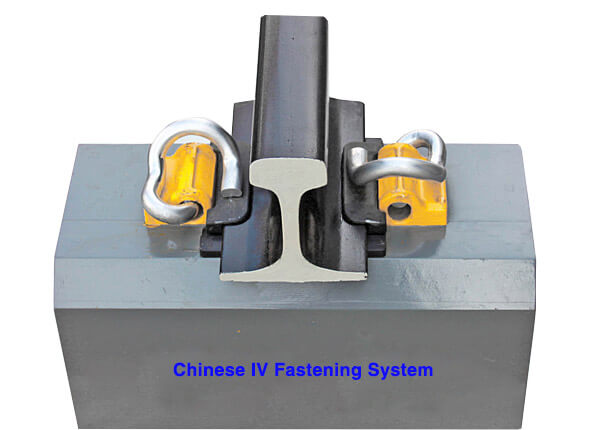
Chinese V fastening system is applied to ballasted track which is laid on pre-stressed concrete sleeper with supporting rail ditches. Its gauge distance and height are adjustable. As far as the whole railway line concerned, W2 clip and rubber pad are adopted at common part, longitudinal resistance shall be >9kn, X3 clip and composite pad adopted at small resistance part, longitudinal resistance 4kn. Rails of both sides can be adjusted to left or right from -4-2mm. Gauge adjustment range is from -8-4mm, height adjustment 10mm.
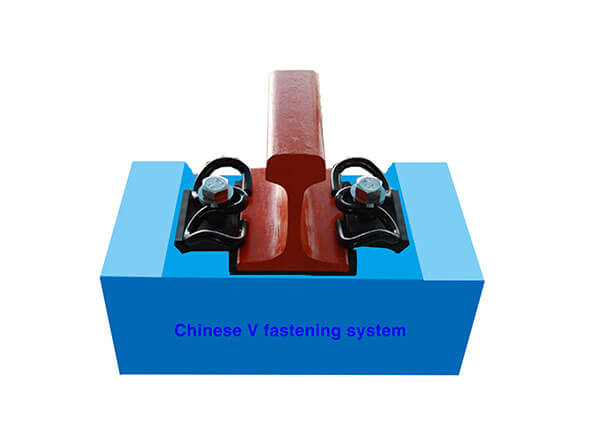
For WJ-7 fastening system tie plate is fixed on track slab by anchor bolts and dowels, rubber pad is installed between rail bottom and tie plate. The system acquires longitudinal resistance of rail from clips of different clamping forces and pad under rail which is pasted together by stainless steel plate and rubber pad. As far as the whole railway line concerned, W1 clip and rubber pad are adopted at common part, longitudinal resistance shall be >9kn, X2 clip and composite pad adopted at small resistance part, longitudinal resistance 4kn. Rails of both sides can be adjusted to left or right from -6-6mm. Gauge adjustment range is from -12-12mm, height adjustment 30mm.
In Chinese WJ-7 fastening system is laid on the lines of part of Wuhan-Guangzhou high-speed railway, Shanghai-Nanjing intercity high-speed railway etc.
For WJ-8 fastening system longitudinal resistance of rail is same as that of WJ-7 fastening system. Rails of both sides can be adjusted to left or right from -5-5mm. Gauge adjustment range is from -10-10mm, height adjustment 30mm.
Insulated block is set on rails and shoulders on tie plate, which not only can buffer the impact on tie plate and but also improve insulation function of fastening system. Pre-stressed concrete sleeper or track slab with supporting rail ditches can slow down the impact of horizontal loading through tie plate, gauge block and ditches.
In Chinese WJ-8 fastening system is laid on the lines of part of Wuhan-Guangzhou high-speed railway, Zhengzhou-Xi’an high-speed railway, Harbin-Dalian high-speed railway, etc.
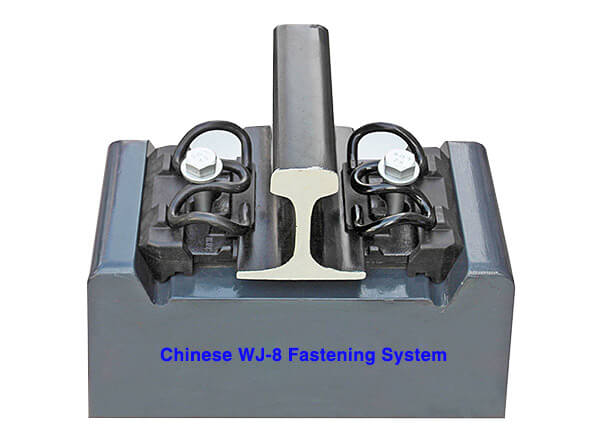
In the world, different rail fastening systems for high-speed railway are used in different countries according to the situations of country, tradition and high-speed running requirements. In order to adapt four basic criteria of high-speed, environmental protection, labor saving and adjustment, systems are developing towards low rigidity, long life, low cost and technical coordination.
We receive enquiries in English, Español (Spanish), Русский язык (Russian), Français (French) and العربية (Arabic). Our professional team will reply to you within one business day. Please feel free to contact us!

